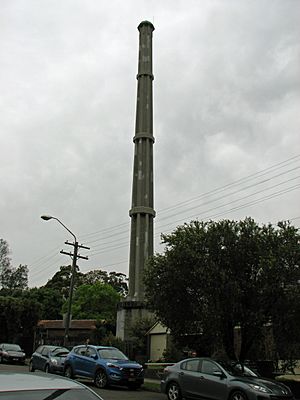Croydon Sewer Vent facts for kids
Quick facts for kids Croydon Sewer Vent |
|
|---|---|

The Croydon Sewer Vent
|
|
| Location | Paisley Road, Croydon, Municipality of Burwood, New South Wales, Australia |
| Built | 1922 |
| Architect | Metropolitan Board of Water Supply and Sewerage |
| Owner | Sydney Water |
| Official name: Croydon Sewer Vent; Sewer Vent; Paisley Road Sewer Vent | |
| Type | State heritage (built) |
| Designated | 15 November 2002 |
| Reference no. | 1639 |
| Type | Other - Utilities - Sewerage |
| Category | Utilities - Sewerage |
| Builders | Metropolitan Board of Water Supply and Sewerage |
| Lua error in Module:Location_map at line 420: attempt to index field 'wikibase' (a nil value). | |
The Croydon Sewer Vent is a tall, special structure in Croydon, a suburb of Sydney, Australia. It's like a giant chimney built to help air out the sewer system. It was designed and built in 1922 by the Metropolitan Board of Water Supply and Sewerage, which is now known as Sydney Water.
This vent is also called the Sewer Vent or Paisley Road Sewer Vent. It's owned by Sydney Water, a government-owned company. Because of its importance and unique design, it was added to the New South Wales State Heritage Register in 2002. This means it's a protected historical site.
Contents
History of the Sewer Vent
The Croydon Sewer Vent is part of a much larger system that helps manage wastewater in Sydney. This system, called the Main Western Carrier, was mostly finished by 1897. It collected sewage from many areas, including the western parts of Sydney.
Why the Vent Was Built
The Croydon Sewer Vent was built in 1922. Another similar vent was built in Burwood in 1919. These vents became necessary because of strong gases coming from the new Homebush Abattoir, a large meat processing plant, which opened in 1916. The gases were causing damage to the sewer pipes. The vents helped to release these gases safely into the air.
Planning the Sewer System
Even before the main sewer system was fully built, local councils like Burwood were asking for ways to deal with sewage. In 1888, the NSW Government told Burwood to wait for the larger Western Suburbs Sewer project. This led to the creation of the Western Branch Main Sewer, which the Croydon Vent serves. If Burwood had built its own smaller system, the main sewer might have been built in a different place.
What the Croydon Sewer Vent Looks Like
The Croydon Sewer Vent is a unique building. It's made of reinforced concrete and was built in 1922.
Design and Structure
The bottom part of the vent is about 6 meters (20 feet) tall and has eight sides. This part is called the pedestal. From the top of the pedestal, the vent becomes a tall, round shaft that gets narrower as it goes up. It has support ribs and three concrete bands around it. Near the very top, there are decorative brackets and a projecting ledge.
Location and Surroundings
The vent is located on a small, triangular piece of land right off Paisley Road. This area is now paved with concrete. Nearby, you can see houses built in the early 1900s, and a railway line is across the road.
There's a steel door on one side of the vent, with a small roof over it. A small metal shed is located a meter away, covering a manhole that leads to the main sewer.
Condition and Visibility
The vent is in good condition, though it has some small cracks and peeling concrete in places. A lightning rod is attached to one side.
The Croydon Sewer Vent is very noticeable. Because of the surrounding landscape and the lack of very tall buildings, you can see it from far away. It stands out as a landmark in the area. There's also an old timber gate post at the entrance to the site, showing how it looked long ago.
Why the Vent is Heritage Listed
The Croydon Sewer Vent is listed on the New South Wales State Heritage Register. This means it's considered very important to the history and culture of New South Wales.
Historical Importance
The vent shows us how the sewer system developed in Sydney, especially the Western Branch Main Sewer. It also reminds us of the problems caused by gases from the Homebush Abattoir, which led to its construction.
Unique Design and Appearance
The vent is a prominent landmark. Its unique design and the way it was built using reinforced concrete make it rare. It's one of only two structures like it in the entire Sydney Water system.
Community Value
The vent is likely important to the local community. It serves a vital purpose in the sewer system and is a well-known landmark in the area.
Research Potential
Studying the vent can help us understand more about the history of engineering and public services in New South Wales. It plays an important role in how the western branch main sewer works.
Rarity
Because of its special design and construction, this vent is considered rare in New South Wales. It's one of only two such structures in the Sydney Water system.
Representation of Sewer Systems
The vent is a great example of how sewer systems work and the important role that ventilation plays in them.

